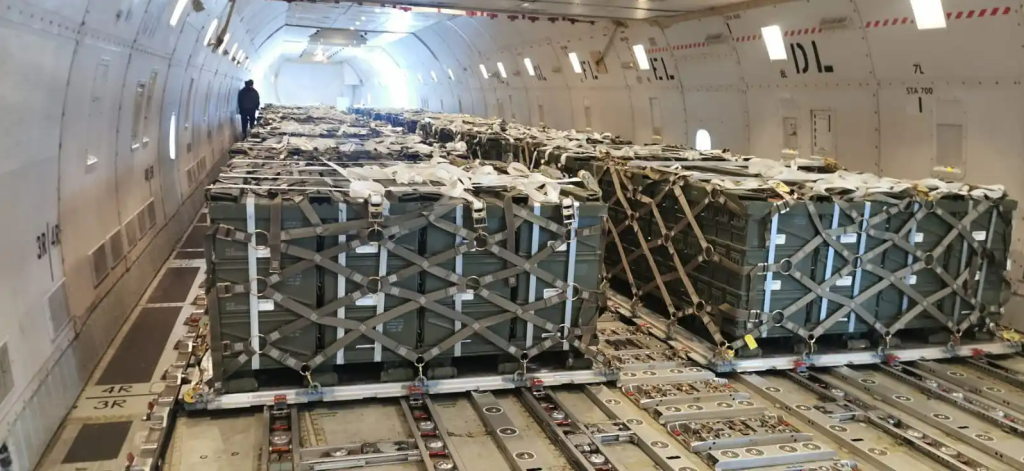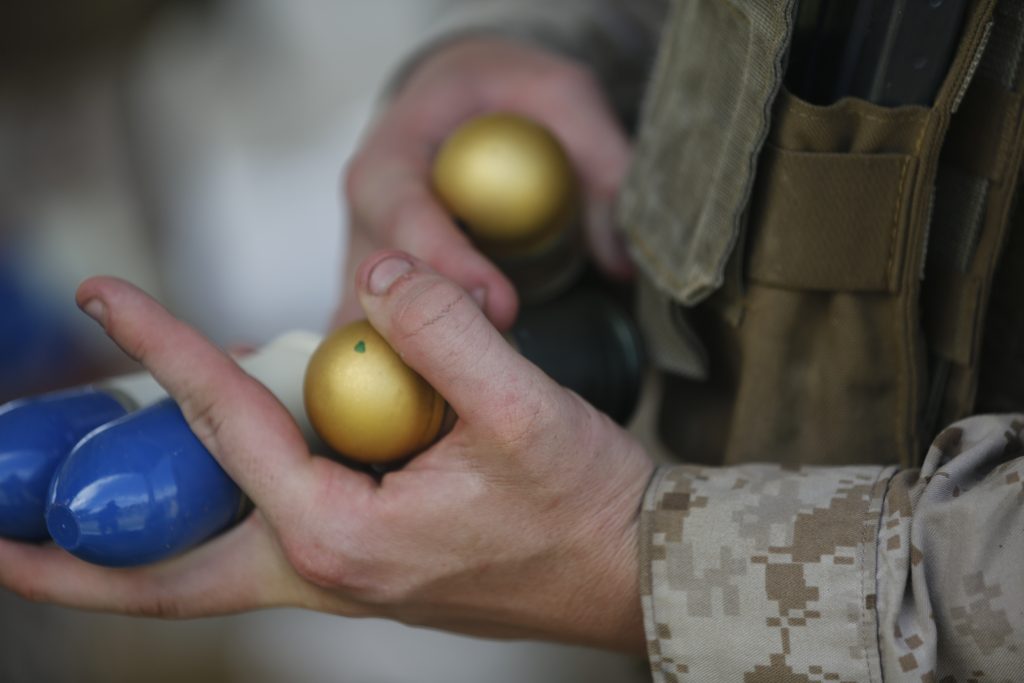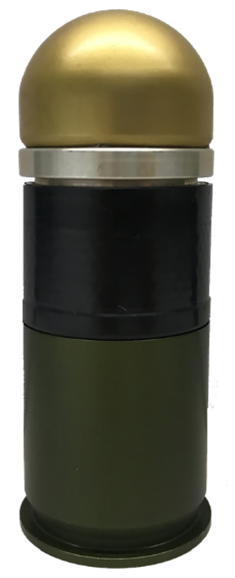
LOADED: A Soldier loads an M320 grenade launcher during a familiarization range hosted by Special Forces in Syria, July 19, 2020. (Photo by Spc. Chris Estrada, U.S. Army 126th Theater Public Affairs Support Element)
JPEO A&A leverages Ukraine funding to deliver a ‘bigger punch’ with an improved, more lethal, accurate and safe 40 mm grenade.
by Maj. Daniel Oesterheld, Anthony Cortese, Jason Wasserman and James Grassi
The United States continues to arm Ukraine with billions of dollars of equipment, armaments and ammunition—including 40 mm high-explosive grenade cartridges—to combat Russian forces as their illegal invasion rages on. As modernization remains a top priority for the Army, leaders directed to replenish U.S. ammunition stockpiles with newer, modernized rounds that add capability, rather than “new, old rounds” that use antiquated and older technology.
Joint Program Executive Office for Armaments and Ammunition (JPEO A&A) Project Manager Maneuver Ammunition Systems (PM MAS) medium caliber team on Picatinny Arsenal, New Jersey is seizing the opportunity to accelerate the development of new and more lethal cartridges—like the 40 mm low-velocity M433E1 high-explosive, dual-purpose (HEDP) cartridge for the M320 grenade launcher—to provide overmatch ammunition to the warfighter in the near term. The HEDP warhead combines penetration ability with a fragmentation effect that lethally reaches a wider area of targets.
To date, the Army has provided Ukraine a combined 77 million rounds of ammunition. That equates to more than $210 million, and includes more than one million 40mm rounds consisting of both the higher penetrating high velocity M430A1 HEDP, fired from the MK19 grenade machine gun, and the low velocity M433 HEDP, fired from M320 and M203 grenade launchers, to accompany the weapons platforms the U.S. supplied Ukraine.

SUPPLY ALLIES: 40 mm grenade shipment in February 2022. (Photo by Ukraine official, Oleksii Reznikov Twitter)
THE 40 MM LOW-VELOCITY M433E1 HEDP CARTRIDGE
PM MAS will rapidly field the new modernized M433E1 HEDP cartridge. The 40mm M433E1 cartridge is a point detonating munition that will be used with the Army’s M320 grenade launcher or legacy M203 grenade launcher attached to the M4 carbine or M16 rifle. It can also be fired from a standalone M320 grenade launcher. Point detonating munitions use a mechanical fuze which arms after launch and functions upon contact, initiating the high explosive charge.
The new modernized M433E1 HEDP focuses on improving and optimizing three areas: lethality, accuracy, and safety. The M433E1 was redesigned to increase lethality within a five-meter radius of detonation against exposed enemy personnel, as well as to improve shot-to-shot dispersion (accuracy and consistency in the landing area) through an optimized aerodynamic shape of the projectile. The major components of the M433E1 HEDP cartridge are the improved fuze, warhead, and cartridge case loading assembly.
LETHALITY
The most impressive and important improvement is the optimization of the warhead to increase lethality and thereby the safety of the warfighter. The new warhead contains significantly more tungsten alloy fragments across the entire warhead—increasing effectiveness and lethality by up to 75 percent, compared to the legacy M433 cartridge—a game changer for grenadiers in close contact with enemy troops in the future.
ACCURACY
The M433E1 HEDP also incorporates a newly designed propulsion system and a more aerodynamic projectile designed to optimize the ballistic performance of the munition. The propulsion system leverages an improved cartridge case designed to accommodate the additional propellent load required to fire the heavier M433E1 projectile. M433E1 is 25 percent heavier than the legacy M433. The improved aeroballistics design of the M433E1 projectile reduces drag on the munition as it flies to target and provides more consistent shot-to-shot dispersion, compared to the legacy M433. The improved propulsion system and aeroballistics shape of the M433E1 projectile will provide the grenadier with increased confidence that they will be able to put rounds on target with increased accuracy and consistency.
SAFETY
The M433E1 uses the improved M550E1 fuze, an upgrade to the M550 fuze on the legacy M433 cartridge. Fuze assembly includes a safety feature that has been proven to prevent early, accidental arming which dramatically improves safe handling of the rounds during transport, and combat conditions.
SOLDIER FEEDBACK
Product Manager Medium Caliber has also been working hand-in-hand with the Program Executive Office for Soldier’s Project Manager for Soldier Lethality, which is responsible for the M320 and M203 grenade launchers that will fire the M433E1. As part of qualification, thousands of rounds will be fired through several M320 grenade launchers, the primary low-velocity 40 mm weapon system used by grenadiers, to ensure weapon compatibility.
With increased lethality comes increased user-felt recoil, so the medium caliber team is working with Soldiers to ensure all risks are identified and mitigated as the effort moves towards final development milestones in the third quarter of fiscal year 2023. The M433E1 packs a bigger punch when firing (more recoil), it also punches harder at the point of impact (more lethal), and with added safety improvements, it gives Soldiers enhanced capability.

WEAPON PRACTICE: A U.S. Marine holds two M781 cartridge 40 mm practice rounds and two M433 high-explosive dual-purpose rounds on Camp Hansen Range 7, Okinawa, Japan, Aug. 12, 2014. The range event was held to increase the Marines marksmanship skills and to check the functionality of the weapon systems. (Photo by Lance Cpl. Colby J. Cooper, Combat Camera, Marine Corps Installations Pacific)
HISTORY AND CURRENT STATUS
The 40 mm low-velocity M433E1 HEDP grenade began as an improvement resupply effort to upgrade the 1960s technology used in the legacy low-velocity 40 mm M433 with modern materials, fabrication processes and analysis. The aim was to develop a new cartridge from the ground up, improving all aspects of the ammunition including warhead lethal effectiveness and aeroballistics. While the government worked closely with industry partners throughout the development of the M433E1, the technical data package is 100 percent U.S. government owned.
In addition to developing the design for the M433E1 HEDP, the government team also leveraged the competency areas and subject matter expertise at Picatinny Arsenal to develop a warhead-fabrication process that ensured that the increased lethality from the M433E1 warhead was producible and affordable. Prototype warheads were fabricated using the government-developed process and were tested and evaluated using several test methods to ensure performance was optimal.
Once the M433E1 design was complete and government prototypes were fabricated and tested, the M433E1 development effort transitioned to industry partners to establish production-level fabrication processes for the M433E1 before entering qualification testing. It is critical to ensure that DOD industrial base can manufacture the cartridge in a high-volume production environment to reduce production costs and increase production output. As such, the M433E1 HEDP design was provided to industry for a producibility analysis and subsequent fabrication of cartridges being used for qualification on production-representative equipment. This analysis will ensure the cartridges being qualified are the most representative of cartridges that would be produced and fielded.
Qualification testing of M433E1 cartridges began in January. The cartridges will be evaluated against requirements developed by the Maneuver Center of Excellence at Fort Benning, Georgia, and upon successful qualification, PM MAS will procure the new M433E1. The first lots of M433E1 cartridges are expected to be delivered into inventory and available for the warfighter at the end of the 2024 fiscal year with full materiel release planned for fiscal year 2025.

UPGRADE: M433E1 exterior. (Image courtesy of AMTEC Corp. and PM MAS)
CONCLUSION
JPEO A&A PM MAS is anxious and eager replace legacy cartridges and field the new modernized 40 mm low velocity M433E1 HEDP cartridge to the warfighter and to Ukraine. The M433E1 gives the warfighter a new low-velocity 40mm tactical cartridge that’s safer, more accurate, and more lethal than the legacy cartridge when fired out of both the M320 and M203 grenade launchers.
As the war between Ukraine and Russia continues, JPEO A&A will continue to look for additional opportunities to replenish inventory with new, modernized cartridges to ensure the Army has the most lethal armaments and ammunition in the world.
For more information go to the Product Manager Medium Caliber webpage: https://jpeoaa.army.mil/Project-Offices/PM-MAS/Teams/PdM-Medium-Caliber./
MAJ. DAN OESTERHELD is the project officer for 40 mm low-velocity M433E1 HEDP and an assistant program manager for Product Manager Medium Caliber with Project Manager Maneuver Ammunition Systems, assigned to the Joint Program Executive Office for Armaments and Ammunition at Picatinny Arsenal, New Jersey. He earned a B.S. in criminal justice from Northeastern University and served as an infantry officer for 10 years before joining the acquisitions corps in 2022.
JASON WASSERMAN is the team lead for Soldier Munitions Special Projects at DEVCOM Armaments Center at Picatinny Arsenal, New Jersey, and the technical lead for 40 mm low-velocity M433E1 HEDP, and one of the designers of the M433E1 warhead technology and cartridge design. He earned an M.Eng. in mechanical engineering from Stevens Institute of Technology, and a B.S. in mechanical engineering from New Jersey Institute of Technology.
JAMES GRASSI is the subject matter expert for the Soldier Munitions Branch at DEVCOM Armaments Center at Picatinny Arsenal, New Jersey and one of the designers of the M433E1 warhead technology and cartridge design. He earned an M.Eng. in integrated product development from Stevens Institute of Technology, and a B.S. in mechanical engineering from Rochester Institute of Technology.
ANTHONY CORTESE is the Soldier munitions branch chief for Product Manager Medium Caliber with Project Manager Maneuver Ammunition Systems, assigned to Joint Program Executive Office for Armaments & Ammunition at Picatinny Arsenal, New Jersey. He earned his B.S. in mechanical engineering from Villanova University and a M.S. in mechanical engineering from Stevens Institute of Technology.







